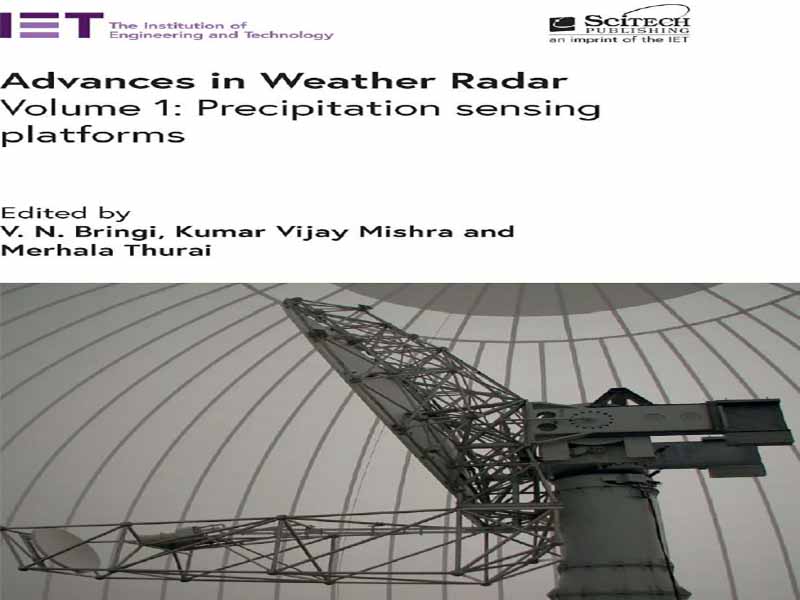- عنوان کتاب: Advances in Weather Radar, Volume 1 Precipitation sensing platforms
- نویسنده: V.N. Bringi
- حوزه: رادار
- سال انتشار: 2024
- تعداد صفحه: 542
- زبان اصلی: انگلیسی
- نوع فایل: pdf
- حجم فایل: 9.86 مگابایت
این مجموعه سه جلدی ویرایششده از کتابهای منتشر شده توسط موسسه مهندسی و فناوری (IET) در مورد «پیشرفتها در رادار آب و هوا» در زیرمجموعه مجموعه کتابهای معتبر SciTech/IET در مورد رادار، سونار و ناوبری قرار میگیرد. ما مفتخریم که این کتاب جدید را که شامل ۳۲ فصل اصلی است و توسط یکی از ویراستاران و یک داور خارجی بررسی شده است، ویرایش کنیم. این فصلها توسط متخصصان فوقالعاده واجد شرایط از دانشگاهها، آزمایشگاههای تحقیقاتی و خدمات هواشناسی ملی نوشته شدهاند که طیف وسیعی از موضوعات نفسگیر را پوشش میدهند. تمرکز این کتاب ویرایششده بر رادار دوقطبی به دلیل کاربرد مهم آن در اندازهگیری بارندگی، در روشن کردن جزئیات فرآیندهای فیزیکی ابر، طبقهبندی انواع پژواک هواشناسی و غیر هواشناسی، اعتبارسنجی و ارزیابی فرآیندهای میکروفیزیکی حجمی که چگالی تعداد و نسبت اختلاط را پیشبینی میکنند و هیدرولوژی رادار در میان سایر کاربردهای جدیدتر است. این فصلها توسط ویراستارانی انتخاب شدهاند که مجموعاً ۸۰ سال تجربه در آزمایشگاههای تحقیقاتی معتبر دارند، در حالی که کل دوران کاری ویراستار اصلی در دانشگاه، اعتبار زیادی به شهرت ما میبخشد. تنها دو جلد ویرایششدهی دیگر موجود است: یکی با عنوان «رادار در هواشناسی» که توسط انجمن هواشناسی آمریکا در سال ۱۹۹۰ منتشر شد و توسط مرحوم دیوید اطلس ویرایش شده و شامل ۴۴ فصل است. این جلد شرح مفصلی از تاریخچهی رادار در هواشناسی پس از جنگ جهانی دوم، موضوعات تحقیقاتی و عملیاتی با استفاده از رادار داپلر و یک فصل در مورد رادار دوقطبی ارائه میدهد. جلد ویرایششدهی دیگر با عنوان «رادار و علوم جوی» مجموعهای از مقالات بود که توسط AMS در سال ۲۰۰۳ به افتخار مرحوم دیوید اطلس ویرایش شده توسط راجر واکیموتو و رامش سریواستاوا منتشر شد، اما تنها یک مقاله به دوقطبیسازی اختصاص داشت. بنابراین، بسیار مناسب است که جلدهای ویرایششدهی بعدی، پیشرفتهای علمی حاصل از ۲۰۰۳ تا ۲۰۲۳ را پوشش دهند، دورهای دو دههای که رادار دوقطبیسازی داپلر در هر آژانس خدمات هواشناسی ملی اجباری شد. از سال ۱۹۸۳ تاکنون چندین کتاب منتشر شده است که به ارائه سطح متوسط تا پیشرفتهای از نظریه رادار داپلر پلاریمتری با تنها زیربخشهای کوچک در کتاب دوویاک و زرنیک (۱۹۸۴) میپردازند که در ویرایش دوم منتشر شده در سال ۱۹۹۳ به حدود یک فصل گسترش یافت. مطالب ویرایش دوم از درسی گرفته شده است که توسط نویسندگان در دانشگاه اوکلاهما به دانشجویان سال آخر و سال اول کارشناسی ارشد در رشتههای هواشناسی و مهندسی برق تدریس میشد. در سال ۲۰۰۱، اولین کتابی که منحصراً به اصول و کاربردهای رادار داپلر پلاریمتری اختصاص داشت (برینگی و چاندراسکار) منتشر شد که به زودی به متن مرجع استاندارد تبدیل شد. این کتاب حاصل یک دوره کارشناسی ارشد در رشته رادار و الکترومغناطیس بود که توسط نویسندگان سالها در دانشگاه ایالتی کلرادو تدریس میشد. در ۱۵ سال بعدی، این کتاب به دلیل توسعه نظریه از اصول اولیه در قالبی مستقل، کتاب درسی مورد علاقه دانشگاهیان و محققان بود. همچنین در این زمان بود که تحقیقات رادار پلاریمتری با سرعت زیادی در حال شتاب گرفتن بود. اخیراً دو کتاب دیگر منتشر شده است (ژانگ ۲۰۱۷) و ریژکوف و زرنیک (۲۰۱۹)، که اولی مبتنی بر نظریه صدا است که ریشه در ریاضیات دارد و بر اساس کلاسی است که توسط ژانگ در دانشگاه اوکلاهما تدریس میشود. کتاب ریژکوف و زرنیک، مونوگرافی است که در سطح متوسط برای هواشناسان و محققان نوشته شده است و آنها را قادر میسازد تا بدون ورود به نظریه ریاضی که میتوان در برینگی و چاندراسکار (۲۰۰۱) یا ژانگ (۲۰۱۷) یافت، درک سریعی از قطبشسنجی به دست آورند. اعتقاد ما، که شاید بدیهی باشد، این است که کتابهایی که توسط خود نویسندگان نوشته و ویرایش شدهاند، در مقایسه با جلدهای ویرایششده که در آنها هر فصل توسط متخصصان نوشته شده و سطحی از جزئیات را ارائه میدهند که در کتابهای درسی یا مونوگرافیها یافت نمیشود، کاملاً متفاوت هستند. با پیشرفتهای سریع در کاربرد رادار پلاریمتری در موضوعاتی که نمیتوان آنها را در کتابهای درسی یا مونوگرافیها پوشش داد، ویراستاران مجموعه ۳ جلدی فعلی کتابها احساس کردند که خلائی در مستندسازی پیشرفتهای اخیر در رادار دوقطبی وجود دارد که منجر به جلدهای ویرایششده فعلی شده است. به خوبی شناخته شده است که موج الکترومغناطیسی با دامنه، فاز و حالت قطبش آن تعریف میشود. برهمکنش موج و ذرات بارش، دامنه، فاز و حالت قطبش را تغییر میدهد. بزرگی مربع دامنهها مربوط به توان پراکنده شده توسط بارش، تغییر فاز ناشی از تغییرات در طول مسیر الکتریکی بارش در امتداد جهت شعاعی که مربوط به فرکانس داپلر است، و ماتریس پراکندگی ناشی از برهمکنش با بارش مانند قطرات باران که غیر کروی و در فضا جهتدار هستند، میباشد. این تغییرات در امواج EM هنگام کمیسازی با حالتهای میکروفیزیکی ذرات، یکی از محرکهای اصلی رادار هواشناسی داپلر دو قطبی هستند. با درک اهمیت دو قطبی شدن، سرویس ملی هواشناسی ایالات متحده (NWS) در یک تلاش بزرگ، Next Gene را نصب کرد.
This edited three-volume set of books published by the Institution of Engineering and Technology (IET) on “Advances in Weather Radar” falls under the prestigious SciTech/IET book series on radar, sonar, and navigation. We are delighted to edit this new book consisting of 32 original chapters reviewed by one of the editors and one external reviewer. They are written by exceptionally well-qualified experts from academia, research laboratories, and national weather services covering a breathtaking range of topics. The focus of this edited book is on dual-polarization radar because of its important application in rainfall measurement, in elucidating details of cloud physical processes, classification of meteorological and nonmeteorological echo types, the validation and evaluation of bulk microphysical processes that predict number density and mixing ratio and radar hydrology among other more recent applications. The chapters were selected by the editors who have a combined experience of 80 years in prestigious research laboratories while the lead editor’s entire career in academia gives strong credibility to our reputation. There are only two other edited volumes available: one on “Radar in Meteorology” published by the American Meteorological Society in 1990 and edited by the late David Atlas consisting of 44 chapters. This volume gives detailed accounts of the history of radar in the meteorology post World War II, research and operational topics using Doppler radar, and one chapter on dual-polarization radar. The other edited volume on “Radar and Atmospheric Sciences” was a collection of essays published by the AMS in 2003 in honor of the late David Atlas edited by Roger Wakimoto and Ramesh Srivastava but contained only one devoted to dualpolarization. It is, therefore, very appropriate that the next edited volumes cover the scientific progress made since 2003–2023 a period of two decades when Doppler dual-polarization radar became de rigueur in any national weather service agency. Several books have been published since 1983 which give an intermediate to advanced level exposition of polarimetric Doppler radar theory with only small sub-sections in Doviak and Zrnic (1984) which was expanded to about a chapter in the 2nd edition published in 1993. The material for the 2nd edition came from a course taught by the authors at the University of Oklahoma to a senior and the firstyear graduate students in meteorology and electrical engineering. In 2001, the first book exclusively devoted to polarimetric Doppler radar principles and applications was published (Bringi and Chandrasekar) which soon became the standard reference text. The book was an outcome of a graduate-level course in Radar and Electromagnetics taught by the authors for many years at Colorado State University. For the next 15 years, it was the textbook of choice for academics and researchers due to its development of the theory from first principles in a selfcontained format. It was also the time when polarimetric radar research was accelerating at a scorching pace. Two more books appeared recently (Zhang 2017) and Ryzhkov and Zrnic (2019), the former based on sound theory rooted in mathematics and based on a class taught by Zhang at the University of Oklahoma. The book by Ryzhkov and Zrnic is a monograph written at an intermediate level for meteorologists and researchers enabling them to gain a quick understanding of polarimetry without going into the mathematical theory which can be found in Bringi and Chandrasekar (2001) or Zhang (2017). It is our belief which is perhaps obvious that books written and edited by authors themselves are a different breed altogether compared to edited volumes where each chapter is written by experts giving a level of detail that cannot be found in textbooks or monographs. With rapid advances in the application of polarimetric radar to topics that cannot be covered by conventional books, the editors of the current 3-volume set of books felt, there was a vacuum in documenting recent advances in dual-polarized radar resulting in the current edited volumes. It is well known that the electromagnetic wave is defined by its amplitude, phase, and polarization state. The interaction of the wave and the precipitation particles changes the amplitude, phase, and polarization state. The magnitude of the square of the amplitudes corresponds to the power scattered by precipitation, the phase change due to changes in the electrical path length of moving precipitation along the radial direction which is related to the Doppler frequency, and the scattering matrix due to interaction with precipitation such as raindrops which are nonspherical and oriented in space. These changes in the EM waves when quantified with particle microphysical states are one of the main drivers of dual-polarized Doppler weather radar. Recognizing the importance of dual-polarization the US National Weather Service (NWS) in a major effort installed the Next Generation (NEXRAD) WSR- 88 Doppler network of 160 radars beginning around 2008. The main NWS goals were two-fold: (a) detection of tornadoes by the mesoscale circulations aloft in supercell storms prior to damaging winds at the ground with lead times of around 20 min, and (b) measuring hourly rain amounts in pixels 4 4 km out to ranges of 230 km for hydrological applications (flash floods and landslides) and land-falling hurricanes which are the most prolific rain producers causing coastal ecological damage and loss of life. Most of the chapters in this book describe the physical properties of the interactions also known as the “inverse” problem which is poorly constrained. Measuring the change of polarization state due to interactions with precipitation is considered as arguably the most important advance since Doppler technology was introduced on a NEXRAD prototype. The few dozen pioneers (one of those pioneers is the lead editor of this three-volume set) who were by and large electrical engineers were astonished by the meteorological and non-meteorological applications that they could not have possibly imagined at that time (1982). This edited three-volume set has many chapters that describe these innovative applications. We hope that these edited volumes will be useful to graduate students, to radar systems designers, to high-level managers of National Meteorological Services, and other research scientists who need to delve deeper into specific topics which cannot be found elsewhere. This volume on “Precipitation Sensing Platforms” focuses on major advances in designing, operating, and deploying weather radars across the globe. The second volume “Precipitation Science, Scattering, and Processing Algorithms” considers theoretical milestones achieved in microphysics, electromagnetics, and signal processing of radar meteorology. The final volume “Emerging Applications” includes applications of weather radars in novel as well as non-meteorological applications.
این کتاب را میتوانید از لینک زیر بصورت رایگان دانلود کنید:
Download: Advances in Weather Radar, Volume 1




































نظرات کاربران